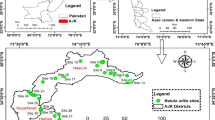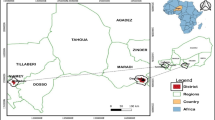Abstract
To understand the human influence on the successional process of vegetation, structures of the pine forest as a dominant vegetation were compared between in Yanghwa-ri of rural Korea and Miwa-cho of rural Japan. The secondary pine forests are well developed around the villages in both regions. In rural Korea, pine forests are still used intensively for several traditional purposes. The pine forests in Yanghwa-ri of Korea, therefore, are stayed in the early stage of the succession. The floristic composition in pine forests of Yanghwa-ri was similar to that in the secondary grasslands. The fertilizer trees such as Robinia and Alnus contributed to develop the stratification of the forest. On the other hand, in Japan, almost all pine forests in rural regions had been abandoned due to the changing of traditional use because of the economic growth and the development of alternative energy sources since 1960s. In the case of pine forests of Miwa-cho, those in the early successional stage were few in number and small in patch size. Several woody plants covered under the pine canopy. The shade-tolerant shrub invaded into pine forest floor, because the undergrowth as a traditional energy source had no longer used. Pine forests were partly succeeded by deciduous oaks in Miwa-cho corresponding to the social changes. On the contrary in Yanghwa-ri, the vegetation replacement will not present because traditional management such as collecting fuels and making graveyards will be remained as a Korean ideology in the rural landscape.
Similar content being viewed by others

References
Braun-Blanquet, J. 1964. Pflanzensoziologie, Grundzüge der Vegetationskunde. 3 Aufl. Springer, Wien, 865 p.
Feoli, E., Lagonegro, M. & Orlóci, L. 1984. Information analysis of vegetation data. Dr. W. Junk bv, The Hague, 143 p.
Forman, R. T. T. & Godron, M. 1986. Landscape Ecology. John Wiley, New York, 619 p.
Fujii, E. 1981. Studies on the regional characteristics of evaluation of Pinus plain forests as open spaces. Tech. Bull. Fac. Hort. Chiba Univ. No. 29, pp. 65–144.
Gauch, H. G.Jr. 1984. Multivariate analysis in community ecology. Cambridge Univ. Press, Cambridge, 298 p.
Holzner, W., Werger, M. J. A. & Ikushima, I. (eds.) 1983. Man's impact on vegetation. Dr. W. Junk, The Hague, 370 p.
Hong, S.-K., Nakagoshi, N. & Nehira, K. 1993. Trends of Pinus densiflora populations under the traditional regimes of forest management in the rural landscapes of Korea and Japan. Annali di Botanica 51: 5–20.
Kamada, M. & Nakagoshi, N. 1990. Patterns and processes of secondary vegetation at a farm village in southwestern Japan after the 1960s. Jpn. J. Ecol. 40: 137–150. (in Japanese with English synopsis).
Kamada, M. & Nakagoshi, N. 1991. The community structure and the dynamics of the secondary vegetation in a rural area of middle Hiroshima Prefecture, Japan. J. Jpn. For. Soc. 73: 276–282 (in Japanese with English abstract)
Kamada, M. & Nakagoshi, N. 1993. Pine forest structure in a human-dominated landscape system in Korea. Ecol. Res. 8: 35–46.
Kamada, M., Nakagoshi, N. & Nehira, K. 1991. Pine forest ecology and landscape management: a comparative study in Japan and Korea. In: Nakagoshi, N. & Golley, F. B. (eds), Coniferous forest ecology from an international perspective. p. 43–62. SPB Academic Publishing, The Hague.
Kim, C.-B., Lee, K.-W. & Kim, C.-S. 1981. The study on the energy supply in rural Korea. Bull. of Korea Rural Economic Institute 42. 256 p. (in Korean)
Kim, T.-C. 1983. Study on the private forest owner's attitudes toward forestland ownership. Bull. of the Coll. of Agri. Chonnam National Univ. 6: 47–57. (in Korean with English abstract).
Lee, S.-Y. 1991. Myonseilram (The Statistics of Kyeryong-myon). Kyeryong-myon, 61 p. (in Korean)
Lee, T.-B. 1985. Illustrated flora of Korea. Hyangmunsa, 990 p. Seoul (in Korean).
Morisita, M. 1959. Measuring of interspecific association and similarity between communities. Mem. Fac. Sci., Kyushu Univ., Ser. E. (Biol.) 3: 65–80.
Nakagoshi, N., Nehira, K. & Takahashi, F. 1987. The role of fire in pine forests of Japan. In: Trabaud, L. (ed.), The role of fire in Ecological Systems. pp. 91–119, SPB Academic Publishing, The Hague.
Nakagoshi, N., Someya, T. & Nehira, K. 1988. Actual vegetation map of Kure, Hiroshima Prefecture. Bull. Biol. Soc. Hiroshima Univ. 54: 13–15 + Map.
Naveh, Z. & Lieberman, A. S. 1994. Landscape ecology: Theory and application. 360 p. Springer, New York.
Nieppola, J. J. 1992. Long-term vegetation changes in stands of Pinus sylvestris in southern Finland. J. Veg. Sci. 3: 475–484.
Numata, M. 1969. Progressive and retrogressive gradient of grassland vegetation measured by degree of succession — Ecological judgement of grassland condition and trend, IV. Vegetatio 19: 96–127.
Ohwi, J. & Kitagawa, M. 1983. New flora of Japan. Shibundo, Tokyo (in Japanese).
Raunkiaer, C. 1934. The Life Forms of Plants and Statistical Geography. 632 p. Clarendon, Oxford.
Rim, Y.-D., Kang, H.-G. & Nakagoshi, N. 1991. Community ecology of Pinus densiflora forests in Korea. In: Nakagoshi, N. & Golley, F. B. (eds), Coniferous forest ecology from an international perspective. p. 43–62. SPB Academic Publishing, The Hague.
Turner, M. G., Romme, W. H., Gardner, R. H., O'Neill, R. V. & Kratz, T. K. 1993. A revised concept of landscape equilibrium: Disturbance and stability on scaled landscapes. Landscape Ecology 8: 213–227.
Yim, Y.-J. 1977. Distribution of forest vegetation and climate in the Korea Peninsula. IV. Zonal distribution of forest vegetation in relation to thermal climate. Jpn. J. Ecol. 27: 269–278.
Yim, Y.-J. & Kira, T. 1975. Distribution of forest vegetation and climate in the Korean Peninsula. I. Distribution of some indecies of thermal climate. Jpn. J. Ecol. 25: 77–88.
Author information
Authors and Affiliations
Rights and permissions
About this article
Cite this article
Hong, SK., Nakagoshi, N. & Kamada, M. Human impacts on pine-dominated vegetation in rural landscapes in Korea and western Japan. Vegetatio 116, 161–172 (1995). https://doi.org/10.1007/BF00045306
Received:
Issue Date:
DOI: https://doi.org/10.1007/BF00045306



